Word study, word work, and spelling…confused about the difference and why it matters in your upper elementary classroom?! These three types of word learning structures often get thrown around interchangeably in the upper elementary teaching world, but they have important differences in approach and purpose. You may have landed on this blog post as a new teacher who really wants to know what distinguishes each practice, as a veteran teacher who’s curious to see if our definitions match, or as someone who falls in between. While word study, word work, and spelling have quite a bit of crossover, there are also some fundamental differences that we should take into consideration.
I was always an A+ speller, but I had everything going for me in that department—I loved to read, my ability to memorize was fantastic, my enjoyment of all things school and my type-A personality allowed me to thrive on practice worksheets, I loved having my mom call words out to me to spell, and I gave myself my own spelling tests to make sure I would do well on the tests…heck, I probably even had index cards to help myself focus on any words with tricky spellings. How many of your students sound like that kind of kid?!
In recent years there has been a shift away from traditional spelling programs where students focus solely on memorizing a list of (possibly) random words in order to perform well on a spelling test. Teachers and parents alike often complain that students are able to perform well on spelling tests but continue to misspell words in their written work. It’s like cramming for a test and then forgetting much of the information once time has passed.
Before we get into my recommendations for an upper elementary word study/spelling program that works, let’s make sure we have a good understanding of the nuances of spelling, word study, and word work.
WHAT IS SPELLING?
Traditional spelling instruction focuses on learning to spell words correctly given a list of words. In upper elementary, how words end up on a students’ spelling list can run the gamut. The word list can be based on a spelling pattern, personalized based on a sight-word assessment, derived from books students are reading, come from content area vocabulary, or a combination of sources. Language Arts textbooks and literacy curriculums often include lists of spelling words and lessons for students to complete but they are often not based on developmental spelling levels or individual students’ needs.
In hopes of differentiating spelling lists, teachers sometimes have students choose half of their words from a class word list and half of their words from a “personal” list of words that students need to master.
While a spelling program can teach phonics and word pattern concepts, the focus is often on memorization, spelling tests, and moving on to new words the following week. Spelling activities often involve repeated activities and practice writing words so that students can spell them correctly when they are tested on them—think “three times each,” rainbow words, word pyramids, ABC order, and more as ways to make it fun for students to write their spelling words again and again.
WHAT IS WORD STUDY?
In word study programs, students are guided to discover and make generalizations about patterns in words and how words work. Word study aims to improve students’ ability to read words, spell words accurately, and understand the meaning of words, including how adding different word parts modify word meanings. “Studying” words is a foundational aspect of word study and moves away from a strict focus on memorizing how words are spelled.
For example, students participating in a word study block may be learning about words that end in -ck and -ke. Through reading, sorting, searching for, and writing words that fit in this particular category, students are guided to discover that most words ending in -ke make the long vowel sound, while most words ending in -ck make a short vowel sound. In word study, students move from noticing similarities and differences in word patterns, sounds, and spellings to being able to verbalize a common rule or way words with those patterns and sounds function.
While spelling words accurately is a goal of word study, so is applying the knowledge of word patterns to spell other words that also follow the spelling pattern; transferring their learning to spell new words is a key goal of word study.
Differentiation is another cornerstone of a true word study program. In classrooms where word study is implemented, students are assessed with a spelling inventory to see where they are in their understanding of phonics and word patterns. The inventory contains a variety of words and increases in complexity to identify students’ mastery of sound patterns and ability to represent the sounds they hear through spelling.
Based on the assessment, students are grouped by their developmental level. For example, students who don’t show a solid understanding of long vowel patterns would not be studying how prefixes and suffixes impact a word’s meaning in the scope of word study (although, the teacher may implement whole group lessons focused on Greek and Latin roots and students will surely encounter those kinds of words in content areas like science and social studies.)
Word study often involves tactile sorting of words on word cards where students group words based on spelling patterns and sounds. Students then document their word sorts by copying it down on paper. This practice helps students think about and come up with ideas about how the words work.
WHAT IS WORD WORK?
Word work is largely used with pre-readers and early readers in preschool and lower elementary grades with a focus on phonics, sight words, and spelling—all critical for our earliest readers! It consists of a variety of teacher modeling, hands-on activities, and games that encourage word building and word reading. In my experience, word work has usually been a component added into students’ guided reading time. Many lower grades teachers try to add a few minutes of word work at the start or end of most of their guided reading lessons.
Word work should bring to mind images of students building words and writing different words repeatedly. During word work, students may learn about word families like -at and -an. They can practice reading and writing new words by changing the beginning consonant (pat/mat/cat and fan/man/pan). Word work is also a time to help students memorize high frequency words that are key for developing as readers. Playing with words and manipulating parts of words is a key component of word work.
WHAT’S AN UPPER ELEMENTARY TEACHER TO DO?
I have found that a well balanced word-learning program has the best aspects of word study, word work, and spelling AND as the teacher, you should be well aware of your goals for whichever program you choose to implement.
I can’t not say this—word study/spelling time needs to be differentiated based on students’ developmental levels. If not, in my experience spelling time just feels like a punishment to some students and a waste of time for others. The days of having all students in a class or grade level working to master and spell the same word list should be a thing of the past for upper elementary classrooms. And, when your students’ assignments are based on their developmental level, they’ll be more eager to participate and have a growth mindset about their spelling and word attack abilities.
Next, we can use elements of word work to bring fun and engagement to our word study program. Games and activities can give students many opportunities to see and work with words and word patterns. These word-work-like experiences will naturally support our upper elementary students in making generalizations about spelling patterns, word pronunciations, and word meanings.
My ultimate recommendation for upper elementary teachers is to create an inquiry-based word study routine where the foundational goal is for students to learn to generalize the consistencies they notice in words in ways that help them become better readers and writers. This routine should incorporate 1-2 days of playing with words and sounds and 1-2 low-stress days that are focused on spelling words accurately. #teachersonamission!
Because I’ve realized that the hands-on FUN was missing from my word study routine, I’ve spent 2021 running down the long path of creating word study games and activities for all levels of word study. These games and centers are aligned to Words Their Way, but can complement any word study program where the focus is on word patterns and sounds. See what these are all about here! With the addition of board games, card games, spinners, and picture board activities, you are sure to find the spark of joy in word study that I’ve felt all these years!
Struggling to picture what this would look like on paper?! Don’t worry! I’ve got you covered in some upcoming posts about word study routines and schedules! Stay tuned! (Or, better yet, grab your FREE Word Study Terminology download and you’ll be updated when I publish new posts about word study!)
HELPFUL RESOURCES FOR UPPER ELEMENTARY WORD STUDY

If you’re a 1st grade teacher, you know that trying to fit everything into your day can seem like an impossible task. First grade word work contains so many different skills!
There are high frequency words, phonics, phonemic awareness, spelling words and grammar. The list seems endless. Take a look at how I fit all of these skills into one easy lesson every day with our first grade word work activities.
What is word work?
We think of word work for first grade as learning about words in all different ways. Students may manipulate letters to build words, look at different phonics patterns, practice sounding out words, learn the patterns in different word families, memorize the spelling of different sight words or other high frequency words and even practice some grammar skills along the way.
Students can practice word work activities at your literacy centers, during writing instruction or independent learning time with a printable worksheet and even for homework. These are all great ideas for fitting word work into your day but we have a daily word study that combines phonics, grammar and high frequency words into one fun lesson.
First Grade Word Work Activities
Most students come to first grade with a letter/sound background. They usually recognize most of the letters and know that letters each make a specific sound. But learning to read is so much more than letters and sounds.
Students must learn that letters go together to form words. Words go together to form sentences. Sentences become paragraphs. Paragraphs go together to form a story.
In addition to all of that, students need to learn grammar rules too. Breaking this down for young children can seem daunting. Each skill builds upon the other, but where do you begin? And how do you fit everything into your day?
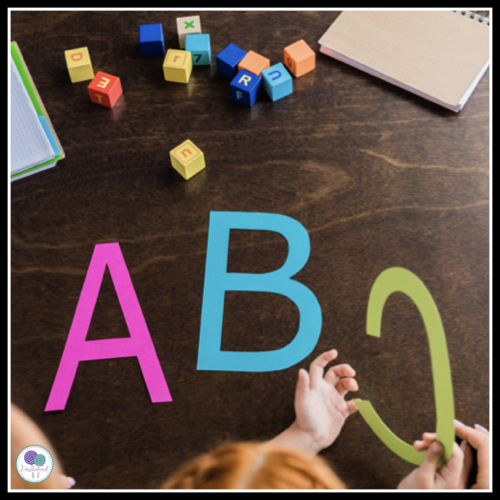
Fitting It All In
When I first started teaching first grade I wondered how I was ever going to fit everything into my day. I knew I needed to streamline my lessons but I didn’t want to leave anything out. All of the skills were important to teach my students how to read.
In our classroom, we use a program called the First Grade Word Study. This simple daily program is perfect for any first grade classroom, because it follows a standard first grade curriculum.
The First Grade Word Study is a year long program that contains 30 lessons. Each lesson includes 4 phonics, grammar and high frequency word activities for each week. All of the activities are contained on one slide for each day.
The slides can be projected onto your board in the front of the classroom. Using this one simple slide, your class can do a daily review of skills that include phonics, high frequency words, spelling and grammar.
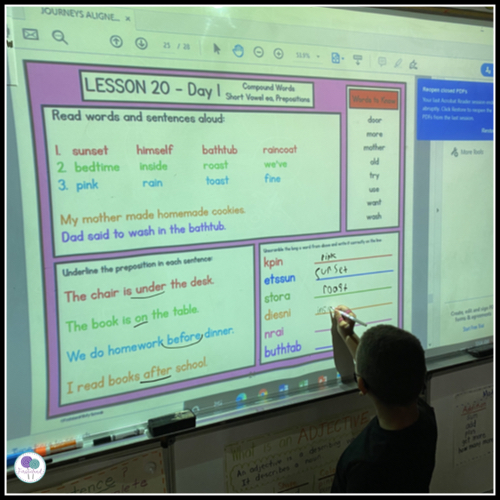
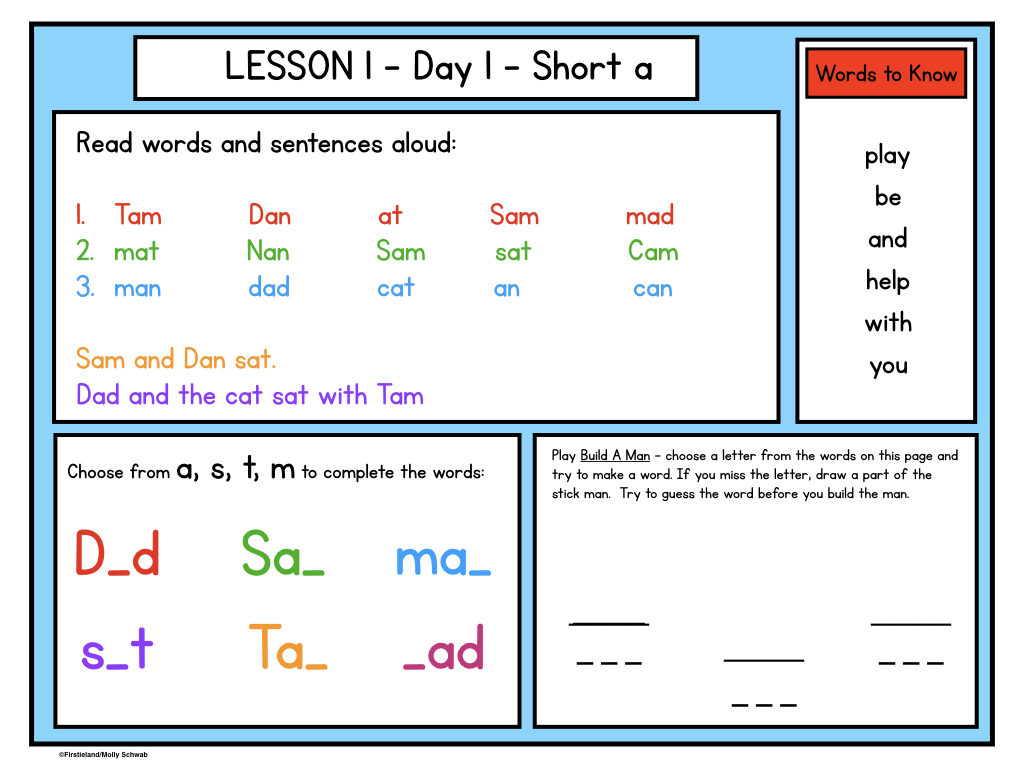
First Grade Phonics
We spend about 20 minutes each day doing our first grade word work. We begin the lesson with a review of our phonics skill for the week. The phonics skills on the word study begin in Lesson 1 with simple CVC words and increase in difficulty as the year progresses. Students practice reading words and sentences out loud.
In our classroom, I call on different students to come up and read a line of words out loud. This is great practice in sounding out words and gives the teacher the opportunity to reinforce letter sounds and how we blend the letters together to make words.
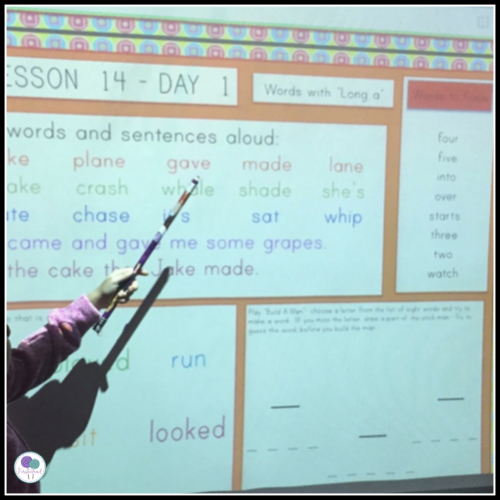
First Grade High Frequency Words
Next, we practice our high frequency words for the week. The first grade word study is editable so teachers can add whatever words their class is working on for the week. During this time, students will practice reading the words out loud and we’ll compare the words to see if any of them have similar qualities. I use this time to help students notice different blends, digraphs, endings, long vowels, and other phonics strategies in their high frequency words.
Sometimes we will play games with our words like Word Wars or Around the World where students will compete to see who can read or spell the word the fastest.
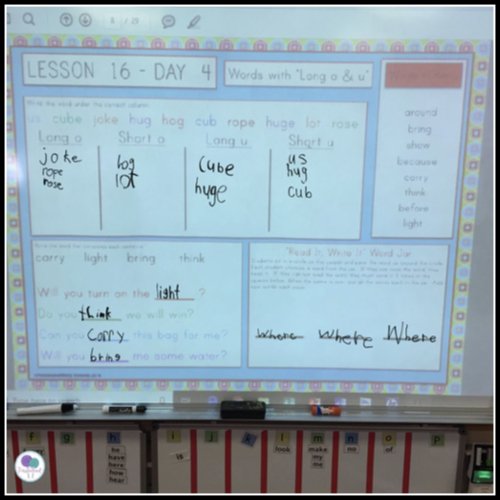
First Grade Grammar
During our first grade word work activities we also learn about grammar. Each week we introduce a new grammar skill such as nouns, verbs, adjectives, preposition, pronouns and more. The students learn how to use these grammar skills in sentences. The first grade word study includes a section for us to practice grammar skills each day.
Students can come up to the board and find nouns or verbs in sentences. Sometimes they will write the missing adjective in a sentence. The skills vary from week-to-week but follow a typical scope and sequence of the introduction of grammar skills in first grade.
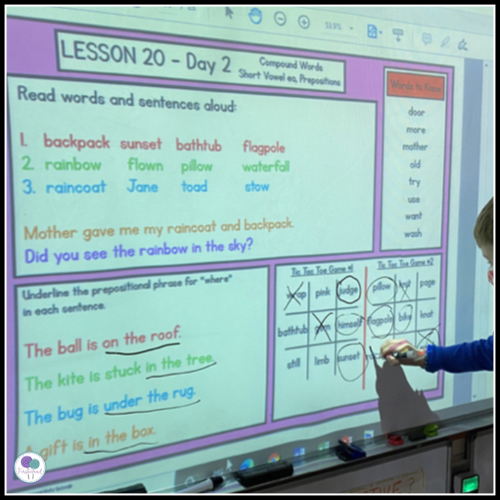
Word Work Games
Finally, we end the lesson with a reading or spelling game. The first grade word study has a daily game that the students love. The games are different each day and include things like Build A Man (similar to hangman but they are building a man instead), Tic Tac Toe, Read It Write It Word Jar and other games. Each game focuses on the phonics skill for that week and students look forward to playing each day.
Students Love the First Grade Word Study
My students actually look forward to our first grade word work. Each lesson is interactive, which gives the students a chance to come up and participate. Students use an expo marker to add letters to words, fill in missing words in sentences and play different word study games on our board.
I love using the word study because I can fit so many important skills into one short 20 minute lesson each day. If you use the Journeys reading series it is especially nice because it includes slides specific to that reading series. However, because it follows a typical phonics and grammar scope and sequence it works for any first grade classroom. The high frequency words are editable so teachers can add any words that they are using in their classroom.
Here’s what other teachers have to say about the First Grade Word Study
“Best purchase! I use these everyday. My students LOVE the tic tac toe and the unscrambling the words. Thank you for making this resource!” – Leah
“I use the daily practice slides 2-3 times a week (as often as my schedule allows). My students love when I use them. I appreciated the organized practice and review that is provided. My students love the variety in delivery. They particularly enjoy tic-tac-toe and the flashlight activities. Thank you for sharing! I have even had a couple of coworkers purchase this resource after seeing me use it with my class.” – Renee
“These are a GAME CHANGER! We adopted Journeys this year and I love it, but I’m also completely overwhelmed by all of it!! These slides are easy to use, clear for students, and help me hit several skills in one sitting. Thank you, thank you, thank you!” – Emily
“My students loved using this resource. It made learning the material hands on and fun for them. Thank you!” – Melissa
“This is my VERY favorite item to help squeeze in a quick 15 minute lesson that is just packed with worthwhile learning!” – Laura
“As a first year teacher this resource saved my life! I am able to fit it in under 20 minutes! My students know what to expect and I get full participation in class! Thank you!” – Andrea
“These activities can be used whole group on a Smart Board or printed and used for center time. My students enjoy the activities, and I love that they’re already planned out with clear explanations for me.” – Stephani
“I use this everyday in my classroom. The kids are thoroughly engaged and love to help fill in the blanks. Very practical. Very useful. Worth every cent.” – Amanda
If you’re struggling to fit everything into your day, and want a resource that packs a punch in your daily word study activities, this just may be the answer you’ve been searching for. It’s a great way to teach all your skills in a quick, easy and fun daily lesson! Take a closer look at this resource here.
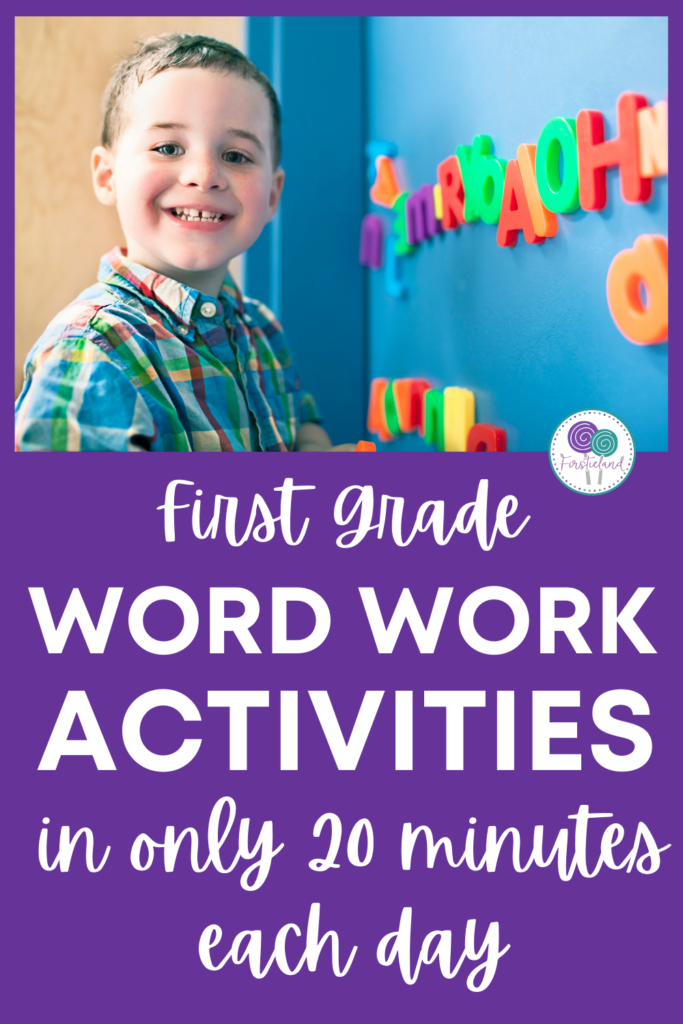
Please follow and like us:
What does Word Work or Word Study look like in your classroom? I’m always curious how teachers incorporate this element of Language Arts into their schedules. Does it have it’s own designated block of time during the day? Is it squeezed in during a chunk of time? Perhaps Word Study is not a part of the day at all. I’ve seen it done all 3 of these ways. My word study/work philosophy has been evolving over the past few years, but it took a MAJOR turn this year after I attended a workshop with Jan Richardson, the amazing teacher and author of «The Next Steps to Guided Reading.»
Let me start by saying that I teach English Language Learners, so word study is an important part of learning a new language, in my opinion. Our word study routine looks something like this… Typically my kiddos receive their word study words on Monday. I use the «Words Their Way» program. After we go over the patterns or the letter sounds of their new words, they sort them and glue them into their word study notebook.
 |
| Word sorts from the Words Their Way spelling program. |
On the inside front cover of their notebook they’ve glued in a «Word Study Activities» page. They use this page to choose various activities. The expectation is that they independently complete one activity each day (Tuesday, Wednesday & Thursday). On Friday they have a word study quiz. This cycle repeats each week throughout the year.
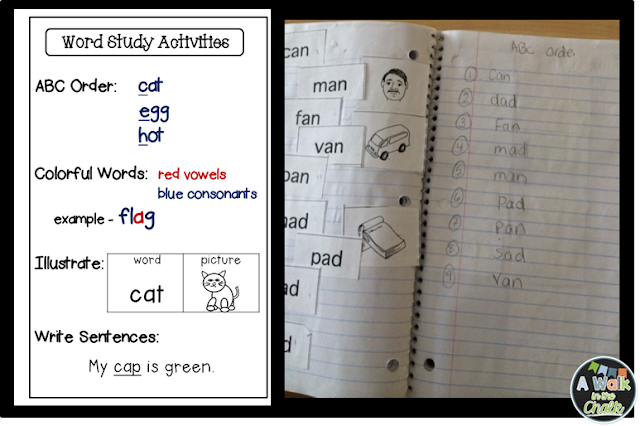 |
*FREEBIE* Click on the image to get the Word Study Activity page.  |
I like to change things up at times, so they may practice sight words during Word Study time. My students really enjoy this «Read It, Build It, Write It» activity from Cindy Gilchrist.
Usually students are working on their word work at the table with me, but sometimes, particularly if I’m assessing students, they’ll work at the Word Work Station.
 |
| This big white board came in handy when creating this Word Work station! |
These word study/word work activities have always worked out well for my students, but it wasn’t until I took a guided reading workshop with THE Jan Richardson (see my post about her here!), that I realized… my students would benefit greatly from incorporating «Word Work» directly into their guided reading lessons! Taking word patterns straight from our reading and doing a mini lesson (3-5 minutes) on those patterns made perfect sense! Of course! Not only does this make their reading more meaningful, but they have another opportunity to practice word attack skills right there in their reading lesson. After this workshop I immediately tweaked my guided reading lesson plan template to incorporate Word Work into EVERY lesson.
Usually I plan ahead, looking for a spelling pattern to focus on in our book. Some examples might be: 2 letter rimes, 3 letter rimes, blends, word endings, double vowel teams, etc. BUT, at other times, I find what students need to work on by simply listening to them read. At the bottom of my lesson plan template I take notes, and when I see a pattern that is causing trouble for a student, well, the whole group may get a little word work mini-lesson on that pattern. The last 3-5 minutes of each lesson is devoted to word work. Each student gets a mini white board and an expo marker. Then we practice making various words with the pattern. The kids love it… and so do I!! 
This addition to my guided reading lessons has been great! Not only do the kids enjoy it, but I see them recognizing those patterns in subsequent books, AND incorporating the spelling patterns in their writing. YES! It has also made ME more aware of the spelling patterns that are challenging for them. This allows me to address those challenges in an effective and meaningful way, right away.
I would love to hear how you incorporate word work or word study into your classroom!
Word work, or word study, is an important part of the balanced literacy approach to teaching reading. This is the time for the teacher to provide explicit, direct, and systematic teaching instruction on the foundation of the English language. This is not a big chunk of our day, but it’s a part of our day that is truly a pillar of reading as students work toward becoming better readers and writers.
Getting started with a word work time in your classroom can be intimidating–when will you carve out time for this? How will you structure that time? What will it look like in your classroom with all of the different ability levels?
When Do I Do Word Work?
I have done this time first thing in the morning and right after shared reading, but before we do reading small groups and literacy stations. It only takes a small amount of time and the gain is worth EVERY minute!
How Does it Work?
In our classroom, I did most word work lessons whole group. For example, if am ready to introduce the long /a/ sound, I will gather the kids on the carpet near the easel and we will do a short lesson together, 5-8 minutes total. I then might pass out dry erase boards and students will practice with me close by so that I can easily see what everyone is doing. During this time I am teaching the English phonics skill explicitly, directly, and with a systematic approach.
You might be thinking, “But what if all of my students are ready for long vowels?” You’re right. They might not be ready for it, but that doesn’t mean I don’t expose it and introduce them to it.
For my students who aren’t ready for this, or who are ready for more than this, I tackle that during reading small group time. I also might differentiate during our word work literacy station. My high students might work on /ai/ and /ay/, while my lowest students might need more practice with short /a/.
You can create your own lessons, or use the lessons provided, but remember, not all lessons that you purchase have a direct approach to teaching. We can never assume that our students “get it” or “just know” when we haven’t explicitly said, “short /a/ makes the sound /a/”.
Favorite Tools

Large Magnetic Letters– I loved that these letters were large and were the perfect size for my teaching easel.
Alphabet Cards to Sort– I would create a different colored set of alphabet cards for each student, which they kept in a ziplock baggie at the desk. They would take them out and sort them into ABC order when we would do a making words lesson (see book below). Grab them FREE HERE.
Words Their Way Books– If you need some help setting up a system and differentiating for your students, these books were favorites of mine! I used them for several years as a guide.
Making Words Books– This was my favorite resource to use with my kindergarten class. We did all of the lessons who group for several months before I allowed the students to do them with their own alphabet cards.
Dry Erase Boards and Markers-These were perfect for more than 1 subject, of course, but we used them during our whole group lessons when I waned the students to show me that they knew how to write with the new phonics skill we just learned.
The deeper our understanding of sounds, the better readers and writers we will become.
If you want to be totally set for word work with everything you’ll need, check out the Kindergarten Word Work Bundle with more than 40 activities in the whole bundle.
There is also a Digital Kindergarten Word Work Bundle. You can use them in the classroom or assign them to students to use while distance learning. You can read more about How to Use Boom Cards and Progress Monitoring with Boom Cards. This bundle covers:
- Rhyming
- Syllables
- Beginning Sounds
- Manipulating Beginning Sounds
- Ending Sounds
- Manipulating Ending Sounds
- Medial Sounds
- Manipulating Medial Sounds
- Beginning Digraphs
- Building Beginning Digraphs
- Ending Digraphs
- Building Ending Digraphs
- Sight Words (dolch list)
The First Grade Word Work Bundle includes more than 60 hands-on activities to use with your students.
These word work activities were designed to be used during reading small groups, but they are also perfect to use during:
- literacy stations
- intervention time
- tutoring groups
Do you have a word work or word study time in your classroom? What does look like for you? What are your favorite tools?
pin it
Activities for phonics, word study, spelling, and all that goodness!
·
Similar ideas popular now
This resource includes six coloring worksheets where students must color the pictures or boxes by vowel sound (long or short). All words and images included are CVC or CVCe words! These will get your kiddos thinking! Included you will find… Six Coloring Worksheets Total:-Short A or Long A Coloring…
Color by Vowel Sound: Long vs Short Vowels CVC/CVCe by Ford and Firsties
Color by Vowel Sound: Long vs Short Vowels CVC/CVCe by Ford and Firsties
*Completely Revised 4.11.19: NEW & IMPROVED!This resource is loaded with printables and games to reinforce the OO (short o) digraph, with the same sound as FOOT! Worksheets, a write the room, matching/memory game cards, Four in a Row game, and an I Have, Who Has game are included! See the previe…
This is a game of I Have, Who Has created to practice reading words with -ing, -ang, -ung, and -ong! There are 24 cards included as well as a printer friendly set. Kids love practicing this while timing themselves — they love to try and beat their old score. ►Words Included: king, bang, long, ding,…
This resource includes a word sort, recording sheet, and other printables for the IE and IGH spelling patterns for Long I. See the preview!►What is included?-Word Sort-Recording Sheet for Word Sort-Word Study Sentences-ABC Order-Highlight and Write-Read & Write-Long and Short I Coloring-Word Se…
This resource includes a word sort, recording sheet, and other printables for the OW and OA Long O spelling patterns for Long I. See the preview!►What is included?-Word Sort-Recording Sheet for Word Sort-Word Study Sentences-ABC Order-Highlight and Write-Read & Write-Long and Short O Coloring-Wo…
This resource contains 3 fun and silly Mad Fill stories all with a Valentine’s Day theme! Students will love practicing their parts of speech, sharing their stories, and illustrating them! They truly are FUN! There are 4 posters included as well. Parts of speech included are noun, verbs, and adjecti…
This is a unit to include multiple worksheets and games for the ING, ANG, UNG, and ONG word families that are welded, or glued, sounds!! This 60 page packet includes… Packet IncludesWord Sort and Recording SheetHighlight and WriteFluency Sentences «Superstar Reading (5 pages)Word Study SentencesABC …
EA Word Work: Long or Short E sound? by Ford and Firsties | TPT
This is a game of Four in a Row created to practice words with -ing, -ang, -ung, and -ong! Students will enjoy trying to get four in a row while they read and practice these words! Six games are included, just PRINT AND PLAY! 
This is a variety of games for the CVVC long vowel teams of AI, OA, EE, and EA. There are 4 fun games in this resource, including Four in a Row, Matching/Memory or Go Fish, I Have Who Has, and Bingo. This resource is great for centers and word study. Let your students have fun and be engaged, all wh…
L Blends: Posters & Matching Game Cards! by Ford and Firsties | TpT
ING ANG UNG ONG [[Word Family GAMES!]] by Ford and Firsties | TpT
Word Family Games BUNDLE #1! [[700+ pages]] by Ford and Firsties
OR, ORE, OAR [[Word Family GAMES!]] by Ford and Firsties | TpT
ISH ASH USH [[Word Family GAMES!]] by Ford and Firsties | TpT
CH vs SH: Games, Activities, Worksheets by Ford and Firsties | TpT
Silent E CVCe: Games Bundle! by Ford and Firsties | TpT
OW OA Long O [[Word Family GAMES!]] by Ford and Firsties | TpT
Long I: IE IGH [[Word Family GAMES!]] by Ford and Firsties | TpT
ACK and OCK [[Word Family GAMES!]] by Ford and Firsties | TpT
ACK «I Have, Who Has?» by Ford and Firsties | Teachers Pay Teachers
OW and OU Word Study: Activities, Games, Worksheets by Ford and Firsties
Beginning Digraph Games: Four in a Row by Ford and Firsties | TpT


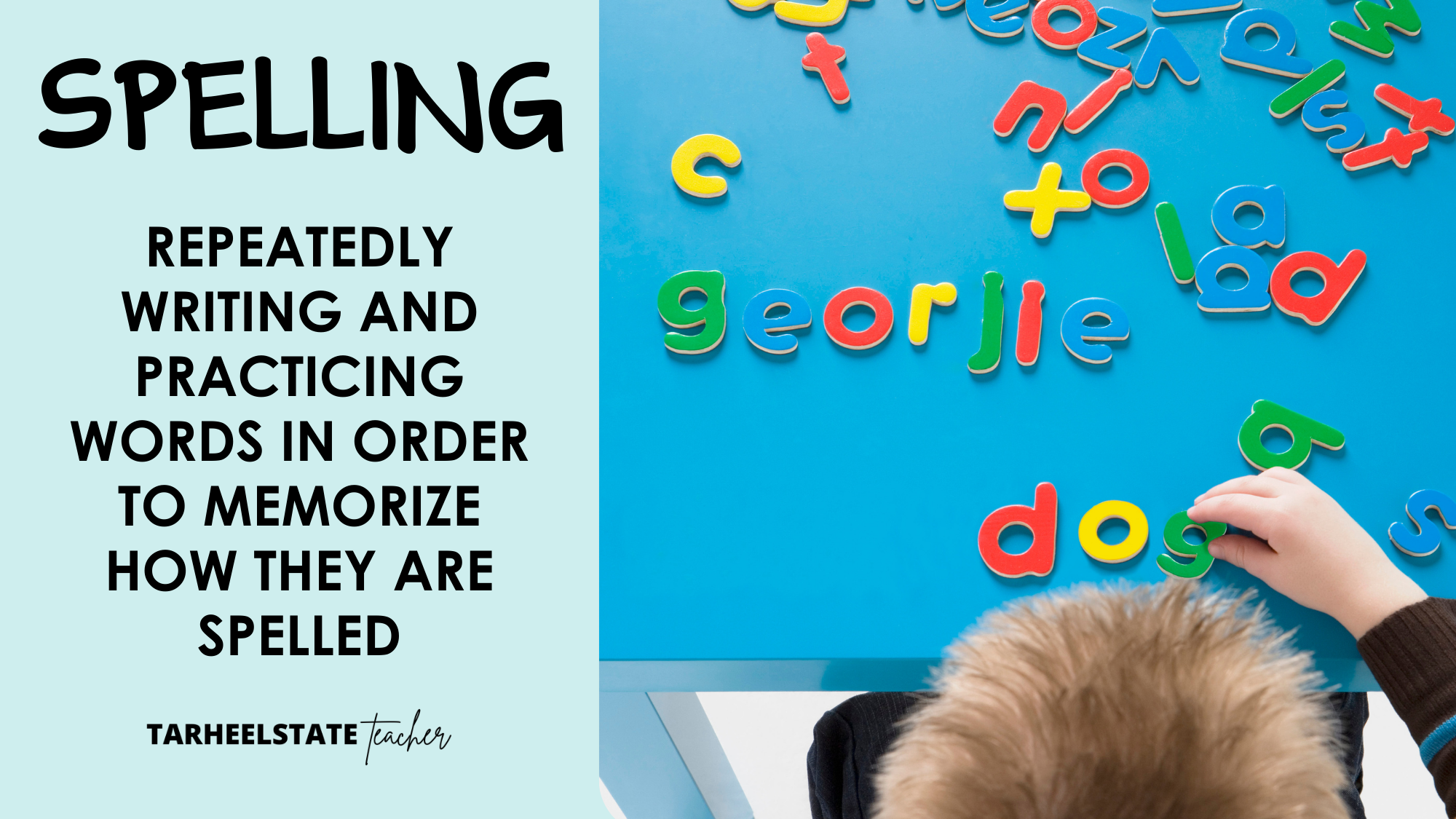



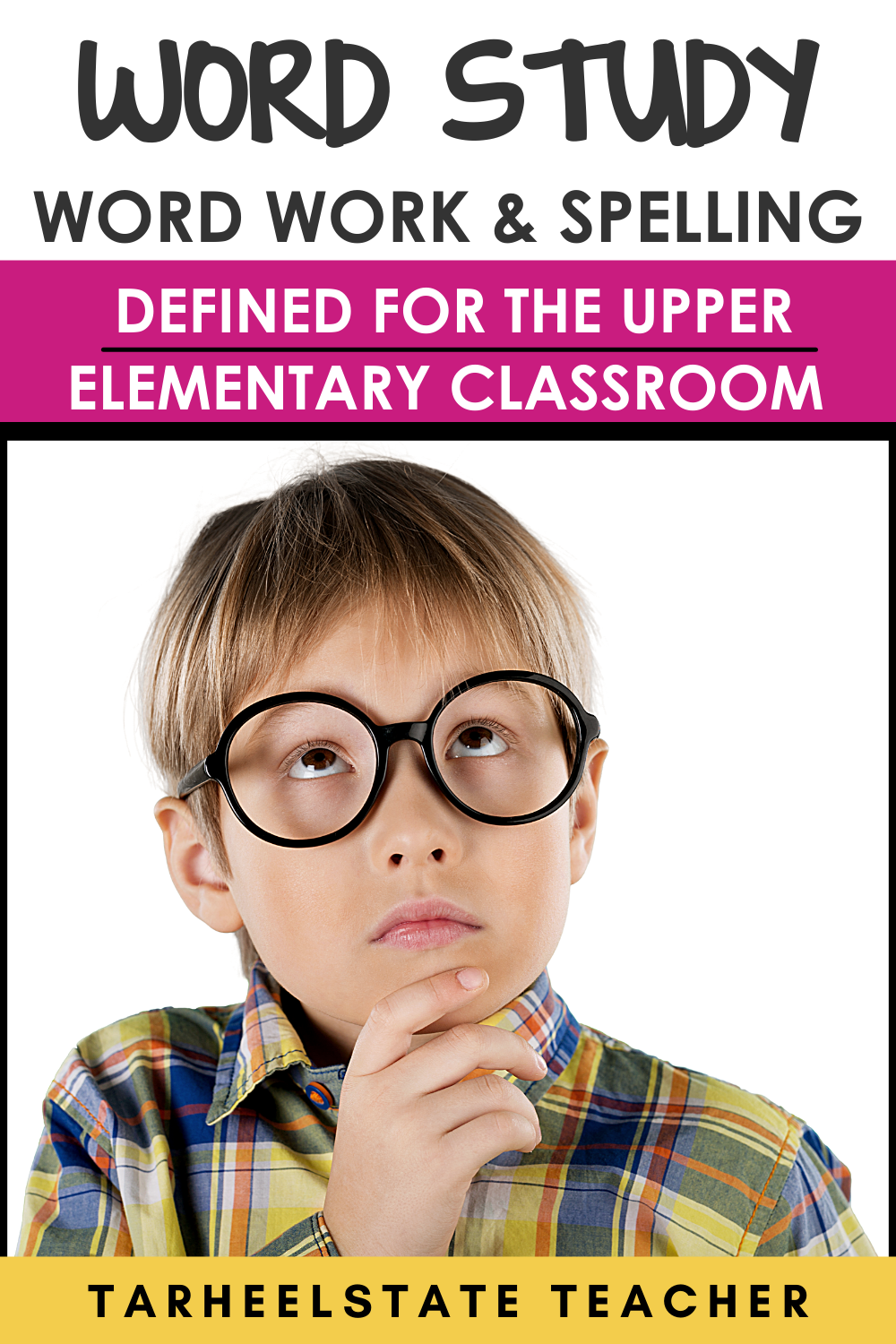
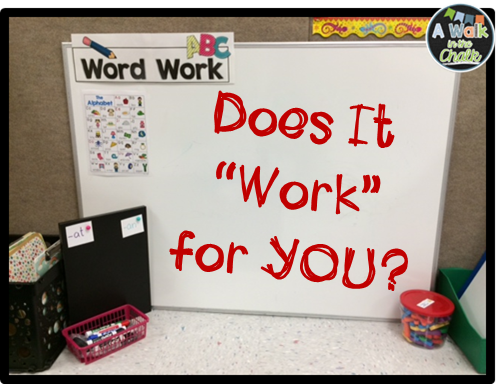
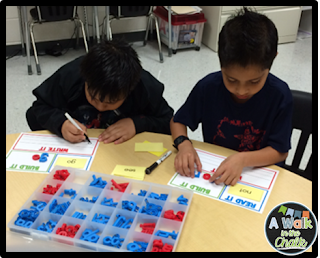






















![ING ANG UNG ONG [[Word Family GAMES!]] by Ford and Firsties | TpT Cvcc, Diphthongs, Different Words, Create Words](https://i.pinimg.com/236x/cc/c5/9a/ccc59af6540497f66a154ca7d89df8fc.jpg)
![Word Family Games BUNDLE #1! [[700+ pages]] by Ford and Firsties The Calling, Calling Cards, 80 Games, Vowel Team, Bingo Board](https://i.pinimg.com/236x/ad/67/a0/ad67a0730c6614229e6154f30029f656.jpg)
![OR, ORE, OAR [[Word Family GAMES!]] by Ford and Firsties | TpT Word Study Centers, Wtw, Study History](https://i.pinimg.com/236x/97/bc/6e/97bc6ec39cba0788352f484d7ee9d69f.jpg)
![ISH ASH USH [[Word Family GAMES!]] by Ford and Firsties | TpT Novel Studies](https://i.pinimg.com/236x/e6/32/be/e632bec69fdc1c60c65969580e54e3c1.jpg)


![OW OA Long O [[Word Family GAMES!]] by Ford and Firsties | TpT O Words, Esol](https://i.pinimg.com/236x/d5/69/db/d569db4b930de8c57b6b07701b517268.jpg)
![Long I: IE IGH [[Word Family GAMES!]] by Ford and Firsties | TpT Pattern Game, Long I](https://i.pinimg.com/236x/07/b1/da/07b1da79d036d0d66bfda28887e48419.jpg)
![ACK and OCK [[Word Family GAMES!]] by Ford and Firsties | TpT Bingo Games](https://i.pinimg.com/236x/c8/60/5d/c8605de79d76bd3cec8a2ccd1a3d0e19.jpg)


